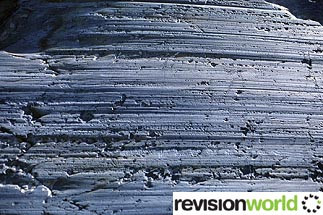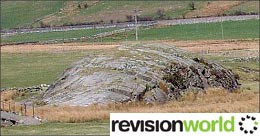Erosion Processes & Features
Ice is capable of transporting huge quantities of rock. Some rocks fall on to the surface of the ice from the valley sides and are transported as supraglacial debris.
Some material finds its way into the ice via crevasses to be transported as englacial debris.
Where there is basal sliding, debris may also be picked up below the ice and be transported as subglacial debris.
Glaciers that move relatively quickly and that transport large amounts of debris at the base, are capable of powerful physical erosion which can drastically alter the pre-glacial landscape.
Chemical erosion, because of the low temperatures is relatively ineffectual.
Weathering, in the form of frost-shattering (freeze-thaw) aids the erosion processes by providing a ready supply of broken rock debris.
If this debris is incorporated into the sides and base of the ice, abrasion becomes active, sandpapering the rock surfaces to produce smooth, gently sloping landforms.
Striations, scratches or grooves are found everyone on bare rock surfaces and are useful to indicate direction of glacier movement.

Plucking is a process that is now regarded as only a minor erosion process as only a small quantity of already fractured rock is capable of being removed by ice which freezes to the rock surface and then moves forward, pulling out the loose blocks.
Plucking produces jagged slopes to landforms.
Roche moutonnees are large rock obstructions that have been smoothed by abrasion on the upstream side (stoss) but have irregular, jagged surfaces on the downstream side (lee) where plucking has occurred.

As glaciers move across the landscape, they come across large rock obstructions such as volcanic plugs or particularly resistant rocks. These outstanding crags remain after glaciation and may protect a tail of softer material which slopes gently away from the crag on the leeward side.
Edinburgh Castle stands on one of these crag-and-tail landforms.
Rates of Erosion
Rates of erosion will vary considerable but are greatest where:
- temperatures fluctuate around freezing point
- where rocks are more jointed and faulted providing weaknesses
- where slopes are slightly steeper leading to more rapid glacier movement (very steep slopes can lead to extended flow, a thinning of the ice and reduced erosive power
- two or more glaciers meet and combine to give an increased depth of ice
- ice moves by rotational flow in corrie glaciers leading to over-deepening of the hollow
